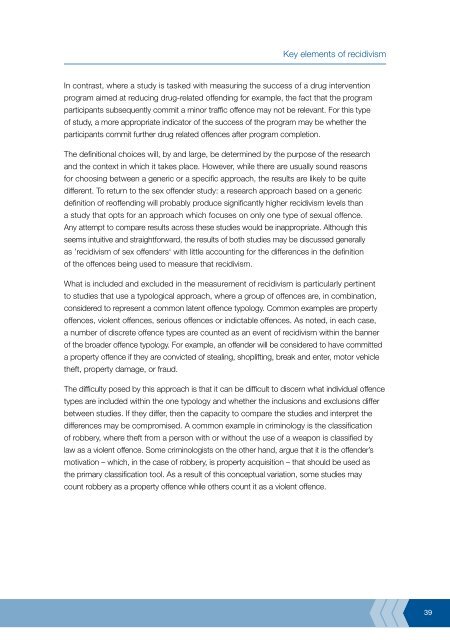Recidivism in Australia : findings and future research - Australian ...
Recidivism in Australia : findings and future research - Australian ...
Recidivism in Australia : findings and future research - Australian ...
You also want an ePaper? Increase the reach of your titles
YUMPU automatically turns print PDFs into web optimized ePapers that Google loves.
Key elements of recidivism<br />
In contrast, where a study is tasked with measur<strong>in</strong>g the success of a drug <strong>in</strong>tervention<br />
program aimed at reduc<strong>in</strong>g drug-related offend<strong>in</strong>g for example, the fact that the program<br />
participants subsequently commit a m<strong>in</strong>or traffic offence may not be relevant. For this type<br />
of study, a more appropriate <strong>in</strong>dicator of the success of the program may be whether the<br />
participants commit further drug related offences after program completion.<br />
The def<strong>in</strong>itional choices will, by <strong>and</strong> large, be determ<strong>in</strong>ed by the purpose of the <strong>research</strong><br />
<strong>and</strong> the context <strong>in</strong> which it takes place. However, while there are usually sound reasons<br />
for choos<strong>in</strong>g between a generic or a specific approach, the results are likely to be quite<br />
different. To return to the sex offender study: a <strong>research</strong> approach based on a generic<br />
def<strong>in</strong>ition of reoffend<strong>in</strong>g will probably produce significantly higher recidivism levels than<br />
a study that opts for an approach which focuses on only one type of sexual offence.<br />
Any attempt to compare results across these studies would be <strong>in</strong>appropriate. Although this<br />
seems <strong>in</strong>tuitive <strong>and</strong> straightforward, the results of both studies may be discussed generally<br />
as ’recidivism of sex offenders‘ with little account<strong>in</strong>g for the differences <strong>in</strong> the def<strong>in</strong>ition<br />
of the offences be<strong>in</strong>g used to measure that recidivism.<br />
What is <strong>in</strong>cluded <strong>and</strong> excluded <strong>in</strong> the measurement of recidivism is particularly pert<strong>in</strong>ent<br />
to studies that use a typological approach, where a group of offences are, <strong>in</strong> comb<strong>in</strong>ation,<br />
considered to represent a common latent offence typology. Common examples are property<br />
offences, violent offences, serious offences or <strong>in</strong>dictable offences. As noted, <strong>in</strong> each case,<br />
a number of discrete offence types are counted as an event of recidivism with<strong>in</strong> the banner<br />
of the broader offence typology. For example, an offender will be considered to have committed<br />
a property offence if they are convicted of steal<strong>in</strong>g, shoplift<strong>in</strong>g, break <strong>and</strong> enter, motor vehicle<br />
theft, property damage, or fraud.<br />
The difficulty posed by this approach is that it can be difficult to discern what <strong>in</strong>dividual offence<br />
types are <strong>in</strong>cluded with<strong>in</strong> the one typology <strong>and</strong> whether the <strong>in</strong>clusions <strong>and</strong> exclusions differ<br />
between studies. If they differ, then the capacity to compare the studies <strong>and</strong> <strong>in</strong>terpret the<br />
differences may be compromised. A common example <strong>in</strong> crim<strong>in</strong>ology is the classification<br />
of robbery, where theft from a person with or without the use of a weapon is classified by<br />
law as a violent offence. Some crim<strong>in</strong>ologists on the other h<strong>and</strong>, argue that it is the offender’s<br />
motivation – which, <strong>in</strong> the case of robbery, is property acquisition – that should be used as<br />
the primary classification tool. As a result of this conceptual variation, some studies may<br />
count robbery as a property offence while others count it as a violent offence.<br />
39















